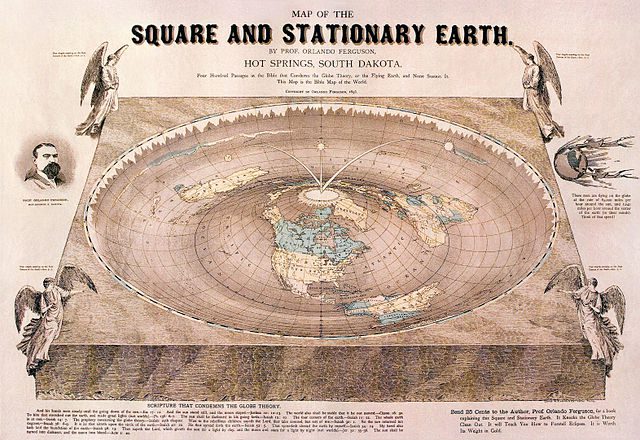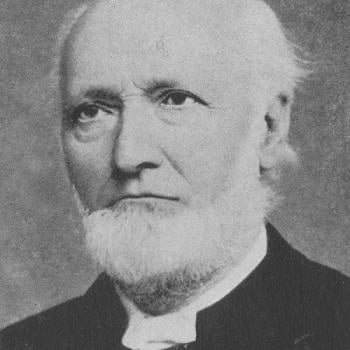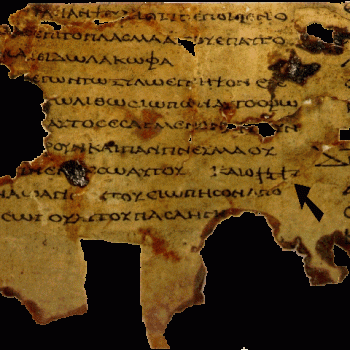Atheist “Proof Texts” Examined (vs. Ed Babinski)

A “flat-Earth” map drawn by Orlando Ferguson in 1893 [public domain / Wikimedia Commons]
***
This is a continuation of a preliminary reply to atheist Matthew Green. In the discussion thread for that post, Matthew’s friend John Loftus suggested his own paper on the topic, and two by Ed Babinski, an agnostic who is particularly interested in Bible-and-science discussions. Matthew then referred to yet another paper by Robert M. Price (one that, indeed, was important to him in his “deconversion” from Christianity).
* * * * *
Now, as usual with these sorts of generally “scattershot” treatments by atheists and agnostics, an effort is made to hit the Christian with dozens or even hundreds of separate “evidences,” the desired cumulative effect of which is supposed to be tremendously debilitating and demoralizing to the Christian. To refute such massively polemical endeavors (even if answers are easily obtainable) is always a hugely tedious affair, requiring starting from ground zero.
Then, of course, if a Christian recognizes this and doesn’t feel like replying to the mountain of alleged “counter-evidence” at any given time, he is accused of cowardice or inability to refute it, or both. Added to those dynamics are my present life situation, in which I feel a bit overwhelmed, with too many things going on, and an excessive amount of stress. In such a circumstance, the last thing one wants to do is undertake a massive research project, requiring hours of excruciating “hard research”.
That said, I do, however, desire to make some response, because the topic (like anything having to do with the Bible) is interesting, and because I think it is an opportunity to illustrate the (inevitable) severe flaws and fallacies of “atheist exegesis.” So I thought I could deal with a few selected arguments on this overall topic, and demonstrate how erroneous and wrongheaded they are. Readers can then see representative examples of the type of “reasoning” being employed against the Bible and Christian apologists who defend it, and see that – once again – it is not a case of “rational, logical, open-minded skeptic vs. gullible, anti-intellectual, closed-minded Christian.”
First of all, it is necessary to give a brief overview of the proper understanding of biblical cosmology. To do so, I shall cite a classic work on the subject, The Christian View of Science and Scripture, by the Baptist Bernard Ramm (Grand Rapids, Michigan: Eerdmans, 1954, 96-102). In his section on “Biblical Cosmology” he offers a very helpful overview of many significant presupposition-level considerations (italics his own throughout) [his words will be in green]:
[T]he references of the writers of the Bible to natural things are popular, non-postulational, and in terms of the culture in which the writers wrote. This principle applies directly to Biblical cosmology. . . . Biblical cosmology is in the language of antiquity and not of modern science, nor is it filled with anticipations which the future microscope and telescope will reveal. We do not agree with over-zealous Fundamentalists who try to find Einsteinian and modern astrophysical concepts buried in Hebrew words and expressions. We also disagree with the religious liberals who object to Biblical cosmology because it is not scientific.
. . . The cosmology of the Bible is not systematized and is not postulational. It is neither for nor against any of the current and ancient theories of the universe except where they might be polytheistic or in conflict with basic Christian metaphysics. But the Bible does not support Aristotle or Ptolemy or Copernicus or Descartes or Newton or Einstein or Milne . . . it gives us no positive cosmology.
We must consider the efforts of radical critics to impose a cosmology on the Bible as an artificial, stilted, and abortive effort.
. . . [William Fairfield] Warren claims that their approach to the cosmology of the Bible is so wooden, artificial, and literal that the Bible writers would not recognize such a cosmology if it were handed them all written out on a piece of paper. If, he continues, you follow this wooden and artificial approach to the Bible you would have the Bible writers believing in a heaven made of wax or silk or goatshair! [The Earliest Cosmologies, 1909, pp. 24-32]
. . . Orr writes:
The error is to be avoided of forcing the language of popular, often metaphorical and poetic description, into the hard-and-fast forms of a cosmogony which it is by no means intended by the writers to yield.
[“World, Cosmological,” International Standard Bible Encyclopedia {“ISBE”}, V, 3106]
. . . Gaenssle, a Semitic scholar, takes the radical critics to task likewise for imposing on the Bible a stilted, artificial cosmology that is nowhere clearly and systematically taught in Scripture [“A Look at Current Biblical Cosmologies,” Concordia Theological Monthly, 23:738-749]. He singles out two basic ideas of this reconstruction of the radical critics to show that their contentions are baseless. (i) He examines the word raqia (firmament) which critics have taken to mean a solid something and indicates that its basic idea is that of thinness or tenuity. Citing Isaiah 40:22, Psalm 104:2 and Isaiah 34:4, he asks:
Can anyone with these texts before him seriously and honestly believe that the writers of these words entertained the crude inept notion of a metallic canopy above their heads?
[Footnote 38: Ibid., p. 743 . . . the greatest Hebrew scholar of the fifteenth century, Paginus, writing well before modern science translates raqia by expansionem]
The best meaning of raqia is expanse or atmosphere. (ii) He also attacks the notion that the world floats on a vast subterranean ocean . . . As for the word under in the phrase “under the earth” the Hebrew word tachath means not only under but lower. In our own day we speak of lowlands . . . :
Consequently, when the earth is said to be founded on the seas and spread out upon the waters, there is no reason to assume that the Psalmist is singing of an invisible ocean on which the earth rests or is spread out, but only of earthly waters on which the earth touches and over which it is elevated.
. . . The upper, terrestrial ocean satisfies all requirements and it lies below or beneath in the same sense as the Dead Sea lies under Mount Pisgah and the land of Moab. [Ibid., p. 747, 749]
Maunder believes that such verses as Job 22:14, Isaiah 40:22 [“It is he who sits above the circle of the earth . . .”] Proverbs 8:27 and Job 26:7 [“He stretches out the north over the void, and hangs the earth upon nothing”] amply prove that the Hebrews thought of the earth as round and suspended in nothing. The unaided eye itself sees the horizon as circular, especially the horizon of the sea. The sphericity of the sun and the moon and the roundness of the stars wold suggest to an astronomically alert people the sphericity of the earth. [E.W. Maunder, “Astronomy,” ISBE, I, 314 ff.]
. . . The pillars of the earth (Job 9:6) are the rocks that bear up the surface of the earth.
. . . It is improper to construct a so-called modern or scientific cosmology from the Biblical evidence; and it is also improper to try to model one after Babylonian concepts. In that there is no systematic exposition of a cosmology in the Bible, and in that the Bible abounds with either popular expressions or poetic expressions, it is not capable of a systematic construction with reference to a cosmology. The best we can do is to (i) indicate the freedom of the Bible from mythological polytheistic or grotesque cosmologies; (ii) note the general hostility of the Bible to cosmologies which are antitheistic; and (iii) clearly present the theocentric view of the Bible towards Nature.
It is typical of radical critics to play up the similarity of anything Biblical with the Babylonian, and to omit the profound differences or gloss over them. When the Biblical account is set side by side with any other cosmology its purity, its chasteness, its uniqueness, its theocentricity are immediately apparent.
Earlier in his book (pp. 66-67, 69-70), Ramm made an even more basic summary of biblical language in relation to science:
A. The language of the Bible with reference to natural matters is popular, not scientific. . . .
B. The language of the Bible is phenomenal. By phenomenal we mean “pertaining to appearances.” . . .
C. . . . the language of the Bible is non-postulational with reference to natural things. By this we mean that the Bible does not theorize as to the actual nature of things . . . . there is no theory of matter in the Bible. . . .
D. The language of the Bible employs the culture of the times in which it was written as the medium of revelation.
E. W. Maunder, in his article, “Astronomy,” in the ISBE (I, 314-315), notes:
The same word (hugh) used in the OT to express the roundness of the heavens (Job 22:14) is also used when the circle of the earth is spoken of (Isaiah 40:22) and it is likewise applied to the deep (Proverbs 8:27). Now it is obvious that the heavens are spherical in appearance, and to an attentive observer it is clear that the surface of the sea is also rounded. There is therefore no sufficient warrant for the assumption that the Hebrews must have regarded the earth as flat.
(1) The earth a sphere. – Certain astronomical relations were recognized very early. The stars appear as if attached to a globe rotating around the earth once in 24 hours, and this appearance was clearly familiar to the author of the Book of Job, and indeed long before the time of Abraham, since the formation of the constellations could not have been effected without such recognition. But the spherical form of the heavens almost involves a similar form for the earth, and their apparent diurnal rotation certainly means that they are not rigidly connected with the earth, but surround it on all sides at some distance from it. The earth therefore must be freely suspended in space, and so the Book of Job describes it . . . Job 26:7.
James Orr, in his article, “World” in the same work (V, 3106-3108), shows how ridiculous it is to think that the Babylonian accounts of creation have much at all to do with the sublime Genesis account. He gives the view of Berosus, a priest of Babylon in the 3rd century B.C. – later confirmed by the discovery of a tablet from the Assyrian king Assurbanipal (7th century B.C.). These show similarity also to the Greek Hesiod’s Theogony (9th cent. B.C.). All postdate the period of David and Solomon by centuries):
[F]rom Chaos came forth Earth, Tartarus (Hell), Eros (Love) and Erebus (Night). Erebus gives birth to Aether (Day). Earth produces the Heaven and the Sea. Earth and Heaven, in turn, become the parents of the elder gods and the Titans. Cronus, one of these gods, begets Zeus. Zeus makes war on his father Cronus, overthrows him, and thus becomes king of the Olympian gods. The descent of these is then traced.
The Egyptian cosmology is even more absurd and fanciful. I won’t bore readers with that account.
With this background, let’s examine some of the glaring errors and whoppers in atheist / agnostic treatment of the alleged biblical cosmology:
Edward T. Babinski, in his article, Did the Authors of the Bible Assume the Earth was Flat?, amply demonstrates the sort of “wooden” interpretation that Ramm mentioned. He writes (his words will henceforth be in blue):
“The devil took him [Jesus] up into an exceedingly high mountain, and showed him all the kingdoms of the world, and the glory of them.” – Matthew 4:8
Shown “all the kingdoms of the world” from an “exceedingly high mountain?”
I suppose so, if the mountain was “exceedingly high” and the earth was flat.
That’s the entire argument from this passage. Note the quick and easy assumption of hyper-literalism. This can easily be refuted even from an “appearance”-based, phenomenological perspective (which was quite possible for ancient Hebrews). Thus, Christian apologist J. P. Holding, in his excellent article on the subject, writes:
Note that even on a flat earth, a high mountain would be a very poor place to observe the kingdoms of the world “in their glory.” Furthermore, if Matthew was implying that a mountain existed from which all the world was visible, then obviously, the mountain would be visible from all parts of the world, and Matthew’s reader’s would roll over laughing and throw his book in the garbage! It is ludicrous to suggest that Matthew believed such a mountain existed.
The parallel verse, Luke 4:5, provides further insight:
And the devil took him up, and showed him all the kingdoms of the world in a moment of time, (RSV)
Alright; this is interesting. How is it, then, that Jesus could have been shown all the kingdoms of the world “in a moment of time”? It makes no sense (under this wooden, hyper-literalist conception that Ed assumes was typical of ancient Hebrews) to think that Jesus could see all the kingdoms of the world in a moment, because they would be in all four directions (indeed, anywhere in a 360 degree circle, up on a high mountain, assuming for the sake of argument only, a flat earth cosmology). Therefore, this is not a literal, physical occurrence, but rather, quite obviously a supernatural one. That being the case, it is impossible to conclude from it alone that a flat earth was the intention (at least of Luke).
Another factor that could easily be explored, is the non-scientific conception that Hebrews had of the notion of “all.” It didn’t always mean “absolutely every so-and-so, without exception.” It could quite possibly mean in many contexts, “many,” “most”, or “a great deal”. The language was pre-scientific and often proverbial, thus allowing for exceptions. Furthermore, exaggeration or hyperbole was often used. So this passage could simply be interpreted to mean “able to see a great distance and many areas / kingdoms.” If that is the case, then the necessity of a flat earth in order to make sight of literally “all” (“absolutely every”) would be rendered null and void, since the intent of the passage wasn’t literal in the first place.
But Ed, undaunted by such considerations of reason, language, and logic, and with the smile of a dupe and gullible fool on his face, gives us another similar “proof” of a flat earth:
Moreover, verses in the Bible’s book of Daniel presume a flat earth the same way that verses in Matthew do:
“I saw a tree in the midst of the earth, and the height thereof was great. The tree grew, and the height thereof reached unto heaven, and the sight thereof to the end of all the earth.”
– Daniel 4:10-11
Instead of an “exceedingly high” mountain from which “all the kingdoms of the earth” can be seen, Daniel pictures a tree “whose height was great,” growing from the “midst” or center of the earth and “seen” to “the ends of all the earth.”
Funny how such flagrantly flat-earth verses appear in both the Old and New Testaments, and both are based on the same simple idea that something “exceedingly high” or of “great height” could be seen by everyone on earth at once.
“Bible believers” like Holding will of course reply that such verses are only “apparently difficult” to explain, and not the “real truth” as they see it. But it is the “apparent difficulties” that remain in the Bible just as it was written, and they will always remain there, regardless of all the ingenuity employed in explaining them away. *smile*
Again, we have a wooden literalism, assuming that ancient Hebrews were idiots (even allowing for their pre-scientific understanding). Does this passage require an interpretation like Ed’s? Nope. It appears to be merely one of hundreds of examples of Hebrew hyperbole and exaggeration.
The context is a dream of the Babylonian king Nebuchadnezzar. Daniel the prophet is asked to interpret it, and repeats similar language in Daniel 4:20. But note, first of all that Daniel doesn’t interpret the dream in spatial or visual terms. Rather, it represents the scope of the king’s power:
it is you, O king, who have grown and become strong. Your greatness has grown and reaches to heaven, and your dominion to the ends of the earth. (Daniel 4:22; RSV)
Now, does it take scientific knowledge for an ancient Hebrew to know that no one man was literally king over the entire earth? No, of course not. This is typically Hebraic hyperbole. It is poetic from the get-go; therefore, it is improper to anachronistically impose modern notions of cosmology onto it, or to suppose that some flat earth cosmology was at all in the mind of the writer. The highly visualized, agricultural, poetic Hebrew mindset is easily seen in a similar passage in Ezekiel (with my comments interspersed in brackets and red):
Ezekiel 31:2-3, 6, 12-13 “Son of man, say to Pharaoh king of Egypt and to his multitude: “Whom are you like in your greatness? Behold, I will liken you to a cedar in Lebanon, with fair branches and forest shade, and of great height, . . . All the birds of the air [absolutely all???] made their nests in its boughs; under its branches all the beasts of the field [absolutely every species???] brought forth their young; and under its shadow dwelt all great nations [every nation without exception?]. . . . Foreigners, the most terrible of the nations, will cut it down and leave it. On the mountains and in all the valleys [every single one?!] its branches will fall, and its boughs will lie broken in all the watercourses of the land [really? Every one?]; and all the peoples of the earth will go from its shadow [every nationality in the shadow of one tree??!!] and leave it. Upon its ruin will dwell all the birds of the air [really?], and upon its branches will be all the beasts of the field [this puts Noah’s ark to shame, doesn’t it?].
It is utterly obvious that passages like these (altogether typical in Hebrew poetry, wisdom and prophetic literature), are poetic; not meant to be taken literally at all. Only a nut or an imbecile could think otherwise with regard to the Ezekiel passage. Since the Daniel passage is pretty similar to it, it is reasonable to suppose that non-literal, non-“scientific” poetry is also in mind, particularly due to the analogous nature of both passages (great trees as a metaphor for the power of kings).
Perhaps Ed and other irrational hyper-skeptics would wish to make hay of the phrase and Hebrew concept of the “ends of the earth”? Using their hackneyed reasoning, one would opine that this (like everything else) is to be taken with wooden literalism: the earth has “ends” so it cannot be a sphere, etc. But how does that work with other verses? How about 1 Samuel 2:10: “. . . The LORD will judge the ends of the earth . . . “? God is judging the corners of the flat earth? Maybe He’ll lop them off and make the edges of the earth smooth, like the edges of an end table? What sense does that make? Clearly, the notion is of totality or very wide scope, not of spatial dimensions or appearance. Thus, the prophetic passages use wide scope to convey great influence, but not necessarily comprehensive power over every person in the entire world. How about Job 37:3?:
Under the whole heaven he lets it go, and his lightning to the corners of the earth.
(RSV, as throughout unless indicated otherwise; NIV has “ends of the earth”)
So God only sends thunderstorms to the corners or ends of the earth but nowhere else? This is Babinskian biblical hermeneutics. What mere mortal could doubt its wisdom and veracity? The profundities of it never cease to amaze one: In Psalm 2:8 God the Father gives God the Son, Jesus (it’s a messianic passage) “the ends of the earth” as His possession? Why just the “corners”? (compare Acts 13:47: only the “corners” or the “ends” of the earth will be saved??!!) In Psalm 19:4 the “voice” of the heavens (19:1) “goes out through all the earth” but the “words to the end of the world.” Compare Rom 10:18, which cites this passage. So we see that the two ways of expressing the same thought show that “end[s] of the world/earth” simply means throughout the whole earth: that is, in all four directions. The same occurs in Psalm 22:27:
All the ends of the earth shall remember and turn to the LORD; and all the families of the nations shall worship before him.
The sense of this phrase is shown in Mark 13:27:
And then he will send out the angels, and gather his elect from the four winds, from the ends of the earth to the ends of heaven.
So much for this line of reasoning. What else can Ed provide us with?
And passages in Matthew (see above) and Revelation (below), demonstrate that the flat earth assumption had by no means vanished by the time the New Testament was written.
The author of the book of Revelation wrote in flat earth fashion: “I saw four angels standing on the four corners of the earth” (Rev. 7:1);
This is more of the same ignorance. ISBE (II, 887: “Earth, Corners of the,” E.W. Maunder) explains:
The “corners” or “ends” of the earth are its “wings” . . . i.e., its borders or extremities. The word in general means a wing, because the wing of a bird is used as a covering for its young, and from this meaning it acquires that of the extremity of anything stretched out. It is thus used in Dt 22:12: “Thou shalt make thee fringes upon the four borders [wings] of thy vesture, where with thou coverest thyself.” It thus also means the coasts or boundaries of the land surface of the earth; its extremities. it is translated “corners” in Isa 11:12; “ends” in Job 37:3 and 38:13. The “four corners of the earth (Isa 11:12) or “land” (Ezk 7:2) are therefore simply the extremities of the land in the four cardinal directions.
Bernard Ramm elaborates:
[I]t speaks of “the four corners [wings] of the earth” (Isaiah 11:12) because the bisection of something into quarters is a frequent human operation and a convenient method of indicating place. To this day it is not uncommon to hear in popular speech such expressions as “from every corner of the earth” or “from all quarters of the globe.” Such expressions are neither scientific nor anti-scientific, but the popular and phenomenal expressions of daily conversations. (Ibid., 67)
But of course Ed cited only about the first third of Revelation 7:1 to begin with. Right after “four corners of the earth” the four angels are also said to be “holding back the four winds of the earth”. Thus it is seen that the meaning is again four directions, as in Mark 13:27, not literally four corners. Jeremiah 49:36 refers to “the four winds from the four quarters of heaven.” Even skeptics like Ed don’t think that the ancient Hebrew cosmology of heaven had four quarters or corners, etc. (see, e.g., the visual diagram that John Loftus provides at the top of his article). So something’s gotta give here.
Or one could cite a passage like Ezekiel 7:1-9, about judgment of Israel by the LORD. In 7:2 it states: “The end has come upon the four corners of the land.” Is God just judging the “counties” of Israel in the corners? Those people liked to live on the edge too much so they got judged? No; it means the whole land will be judged: the land in all directions. This no more means that the land of Israel was literally a square or rectangle than the phrase applied to the earth meant that it was flat and had literal corners or “ends.” The same dynamic is seen in Revelation 20:8, where Satan is said to “come out and deceive the nations which are at the four corners of the earth . . .”
Ed writes: “I should think that a perusal of the Bible should be enough to make anyone realize how naive the Bible’s view of the cosmos was.” to which I reply: I should think that a perusal of Ed’s interpretation of the Bible should be enough to make anyone realize how naive and utterly simplistic his view of biblical hermeneutics and exegesis and the intelligence of ancient Hebrews is.”
And according to Genesis 1:16 only “two” great lamps (the Hebrew term translated as “great lights” in Genesis, means literally, “great lamps”) were created, the “Sun” and the “moon”–with no recognition of the fact that the stars are also “great lamps.”
From a phenomenological perspective they aren’t. I’ve hiked by the full moon at night and I could see perfectly well. But try doing that by the light of the stars alone. This is the point. But Ed misses it, as usual, because he is unreasonably trying to find scientific expression and modern astronomical metaphysics in the Bible.
Rather, the Bible depicts “stars” as relatively small objects, created after the earth and “set” in the firmament above it, . . .
Of course, since stars are “relatively small objects” from our earthly perspective! Where’s the beef?
Astronomers, not theologians, discovered that we live on one planet out of many, circling one star out of many, that lies near the end of one arm of a spiral-shaped galaxy, again one out of over a hundred billion galaxies.
It’s not the purpose of theologians or the Bible to “do science” anymore than it is the purpose of scientists to do theology. Yet the ancient Hebrews knew that the universe had a beginning. Modern science only figured that out some forty years ago when Big Bang cosmology became the reigning orthodoxy. The Hebrews had a sublime monotheistic cosmology while the Greeks at the same time were still talking foolishly about Zeus and other gods. So this “we discovered it first” routine works both ways.
Even after the New Testament was written, and the early church fathers began commenting on its contents, some of them remained flat earthers.
That’s right, but so what? Of what relevance is this to anything? If you want to trade stories of ignorance (inexcusable or not) there is, again, plenty to go around. I’ve noted how Galileo, the champion of atheists (so they think) against the Church, was heavily into astrology (a fact that comes as a surprise precisely because it has been suppressed by critics of the Church, due to its not fitting into the stereotype they wish to convey). The same was true of Kepler, who discovered the elliptical orbits of the planets. Newton was an enthusiastic proponent of alchemy.
Modern science committed errors (only a hundred years ago or less) like phrenology, whereby the shape of one’s skull was thought to be a decisive indicator of intelligence. Thus science was brought into the service of overt racism, just as with eugenics: with plans to sterilize blacks and other “inferiors” embraced by enlightened types like Margaret Sanger, the founder of Planned Parenthood, who was enamored with the Nazis. We all know what sort of scientific experiments the Nazis did, too. Germany was, of course, one of the most advanced nations in terms of science, in the world, then and now.
Likewise, the sources that Matthew Green cites as definitive in his accepting this biblical skepticism, Dr. Robert M. Price and Reginald Finley Sr., in their article (section: “Welcome to the Flat Earth Society!”) come up with what they think is a compelling argument (after trying the fatally flawed arguments from Matthew 4:8, Daniel 4:10-11, and the “four corners” which have been mercilessly disposed of above):
Isaiah 42:5 and 44:24 state that at creation God “spread out the earth”- the Hebrew verb for “spread” being used elsewhere in Scripture to depict a “flattening” or “pounding.” Also, if the earth was not “spread out,” but “rolled up tightly like a ball” at creation, the writer could have said so. We find the requisite Hebrew construction in Isaiah 22:18, where a man is “rolled up tightly like a ball.” Hence the earth at creation was spoken of as being “flattened or pounded flat” at creation.
The Hebrew word is raqa (Strong’s word #7554). As usual, these skeptics omit what doesn’t fit into their scheme, while presenting facts which appear at first glance to support their contentions. But why not look at the whole story? What do we have to fear from facts, anyway?
Gesenius’ Hebrew-Chaldee Lexicon to the Old Testament defines the use of the word in these passages as “to spread out by beating . . . and simply, to spread out, e.g., God the earth, Ps. 136:6; Isa. 42:5; 44:24.” Does this necessarily have to mean “flat”? Not at all, for in Isaiah 40:19 the same word is used of overlaying gold over an idol, which is not flat, but usually a three-dimensional depiction of a man or an animal. In Job 37:18, God “spread out (raqa) the skies” – and even skeptics do not think they are flat in Hebrew cosmology.
As for Isaiah 22:18, my Revised Standard Version has: “He will seize firm hold on you, and whirl you round and round, and throw you like a ball into a wide land . . .” Other translations (NIV, NASB) are more like the rendering above, but this doesn’t prove that Isaiah 42:5 and 44:24 are inherently contrary to a spherical earth. They don’t contain enough information to decide what shape the earth is.
And so on and on goes the skeptic clattering. It’ll never end. But it isn’t decisive at all. I agree with the conclusion that J.P. Holding made after examining several of these attempts:
[F]or the majority of the cites we have seen, there is . . . merely misinterpretation by skeptics and/or poetry. We are justified in our assertion that there is no proof that the Bible teaches a false cosmology.
***
Here are some helpful sources on the topic of biblical cosmology (I don’t necessarily agree with everything in every article):
Does the Bible Teach that the Earth is Flat? (J. P. Holding)
Does the Bible Teach a Spherical Earth? (Robert J. Schneider, Sep. 2001) [especially interesting in its analysis of Is 40:22: “circle of the earth”]
***













